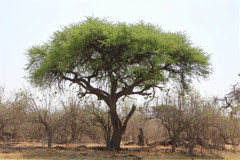
Camelthorn acacia in Northern Botswana
Acacias are one of the largest genera of trees and shrubs in the world, with nearly 800 species.
Belonging to the pea family, acacias have pods, and acacia beans are on the menu in some countries. Many of the African acacias are now reclassified into the separate genera 'Vachellia' but are still in the Acacia Tribe.
The flat-topped crowns of the umbrella thorn (Acacia tortilis) on vast African savannahs such as the Serengeti are adapted to
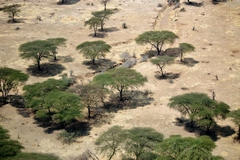
Acacias in Ruaha
their semi arid environment. The exaggerated umbrella-shaped crown enables the trees to capture the maximum amount of sunlight, with the smallest of leaflets.
The umbrella tree tolerates extensive summertime heat and drought as well as dry, saline and alkaline soils. It survives on as little annual precipitation as 1 1/2 inches to as much as 47 inches.
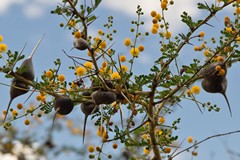
The bright yellow flowers of the whistling thorn
Acacias shallow roots can extract any moisture from the soil above the hard pan. They grow to around 6m tall.
Extensive browsing by giraffes can prune the understory branches of acacia trees.
African acacias have fern-like, bipinnate leaves subdivided into numerous minute leaflets. Acacia flowers are clustered together in small yellow or white globose heads, or in cylindrical spikes.
The famous "whistling thorn" of Kenya has bulbous thorns occupied by very aggressive stinging ants of the genus Crematogaster that protect them from browsing herbivores. The ants hollow out the soft green thorns for living quarters.
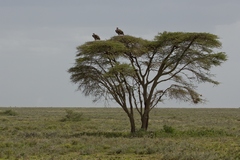
White-headed vultures on an umbrella thorn
Giraffes and other herbivores normally eat thorny acacia foliage, but leave the whistling thorn alone. In fact, for most African acacias, spines alone are no deterrent to giraffes.
The swollen thorns are not galls, they are not produced in response to stimuli from invasive insects. The amazing thorns are genetically-programmed structures that are formed with or without the presence of symbiotic ants.
Old thorns which have been vacated by the ants make a whistling sound as wind blows across the entrance hole.
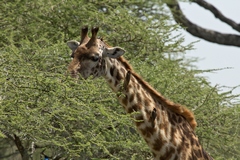
Maasai giraffe browsing on an acacia bush.
Their long tongues are adapted to strip the
leaves from the branches despite the thorns
Four species of stinging ants live symbiotically on whistling thorns. Since these different species of ants are enemies, they occupy separate trees. If acacia branches containing rival ant colonies make contact, the different species of ants will fight each other, with the loser being evicted from its tree.
The relationship between these ant species and their acacia is not always mutualistic because it may harm the acacia tree. Crematogaster mimosae and C. sjostedti both tend scale insects that feed on the tree's vascular system, milking the aphid-like insects for their nutritive honeydew secretions and C. sjostedti pays little attention to herbivores that attempt to feed on the tree.
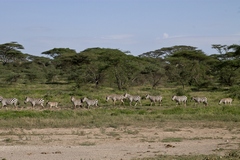
Migrating zebras in acacia woodland at
NDutu in the NCA
Being inhabited by aggressive insects could make it difficult to get the tree's flowers pollinated, so the tree needs to stop the ants from attacking the pollinators on the flowers. To do this, the flowers seem to produce chemicals that are repellent to the ants as well as other compounds to draw in pollinators such as bees with their irresistible aromas.
Leaves of the acacia tree emit ethylene into the air when attacked by antelopes or giraffes. Ethylene travels up to 50 yards and alerts other nearby trees of the predators, which within 5 to 10 minutes produce lethal quantities of tannin in their leaves, Tannin makes the leaves unpalatable and could lead to the browser's death if it kept on eating.
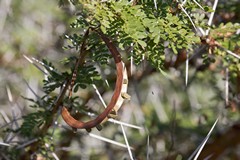
Acacia seed pods
Some species couldn't survive without elephants. Seed pods contain beetle larve that eat the seeds. Elephants eat the pods but don't grind them up enough to destroy the seeds as monkeys do. However the digestive juices will kill off all the larvae and 90% of the seeds that pass through an elephant will germinate. Those seeds left in pods on the ground are almost all eaten by beetles.
Simulating large mammal extinction, by stopping them eating the trees, causes the ant-plant mutualism to break down. Less housing for the ants and less sugar rich nectar is produced as the trees no longer have need for protection from large browsing mammals like giraffes.
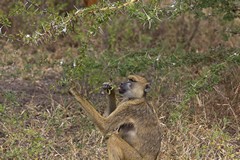
A yellow baboon eating seed pods
Eventually the 'good' ant leaves. Other ant species that do not protect the trees from herbivores take over, and these ants help a wood-boring beetle to create tunnels inside the acacia tree, which the ant then uses as nesting space.
Trees occupied by this new type of ant grow more slowly and experience double the death rate compared with trees occupied by the mutalistic ant. This takes place over a 5-10-year period.
One of the most important natural plant gums is gum arabic, obtained from the spiny, shrubby Acacia senegal of northeastern Africa.
The Ark of the Covenant is said to be made out of acacia wood.
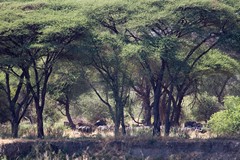
Gallery forest provides welcome shade for a
herd of buffalos
The Tree of Ténéré, was a solitary acacia, the only one for over 400 kilometres (250 mi). It was a landmark on caravan routes through the Ténéré region of the Sahara in northeast Niger, so well known that it and the Arbre Perdu or 'Lost Tree' to the north are the only trees to be shown on a map at a scale of 1:4,000,000. The Tree of Ténéré was located near a 40-metre (131 feet)-deep well. Sadly, it was knocked down by a drunk truck driver in 1973.